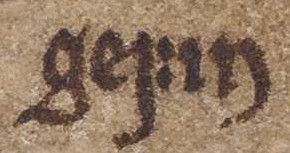1. Dróttkvætt
Kari Ellen Gade 2009, ‘Dróttkvætt’ in Kari Ellen Gade (ed.), Poetry from the Kings’ Sagas 2: From c. 1035 to c. 1300. Skaldic Poetry of the Scandinavian Middle Ages 2. Turnhout: Brepols [check printed volume for citation].
The bulk of the poetry contained in SkP II is composed in dróttkvætt ‘court metre’, which also formed the backbone of Háttatal and was the foundation for Snorri’s prose commentary. A dróttkvætt stanza contains eight lines with six metrical positions in each line. The odd lines (i.e. lines 1, 3, 5 and 7) have two alliterating staves which alliterate with the first syllable (hǫfuðstafr) in the even lines (i.e. lines 2, 4, 6, and 8). Unlike other Germanic alliterative poetry, dróttkvætt lines also contain internal rhyme, which involve the vocalic onset and the postvocalic environment of a syllable. The odd lines have skothending ‘inserted rhyme’, in which the vocalic onsets of the two rhyming syllables can be different but the postvocalic environments must be identical (e.g. -áð- : -éð-), whereas the even lines have aðalhending ‘noble rhyme’, which requires both identical vocalic onsets and postvocalic environments (e.g. -áð- : -áð-). Each line ends in a cadence (a word consisting of long plus a short syllable), and the second skothending or aðalhending always falls on the long syllable in metrical position 5. Consider the following half-stanza (Hharð Lv 14/1-4; the alliterating staves appear in bold and the syllables with internal rhyme are italicised here and passim):
Krjúpum vér fyr vápna
(valteigs) brǫkun eigi,
(svá bauð Hildr) at hjaldri,
(haldorð) í bug skjaldar.
Vér krjúpum eigi í bug skjaldar at hjaldri fyr brǫkun vápna; svá bauð haldorð Hildr valteigs. ‘We [I] do not creep into the hollow of the shield in battle because of the crash of weapons; thus the faithful Hildr <valkyrie> of the falcon-field [arm > woman] commanded.’
Dróttkvætt was the most popular and prestigious skaldic metre, and it is used in both praise poetry and lausavísur throughout the period covered by the SkP II editions (c. 1035-1300). In the individual SkP II editions, no mention is made of the metre if the poetry is composed in dróttkvætt.
A variant of dróttkvætt that does not contain internal rhyme, and where the main stave (hǫfuðstafr) in the even lines falls on the first stressed position and need not be fixed in position 1, is háttlausa ‘lack of form’. Steigar-Þórir’s kviðlingr (SteigÞ Kv, c. 1094) and an anonymous stanza from Knýtlinga saga (Anon (Knýtl), c. 1080) are composed in that metre.
